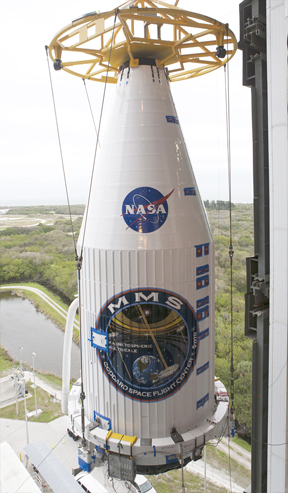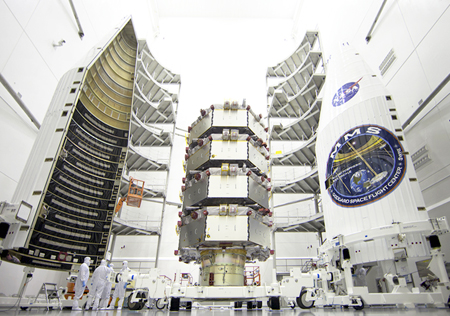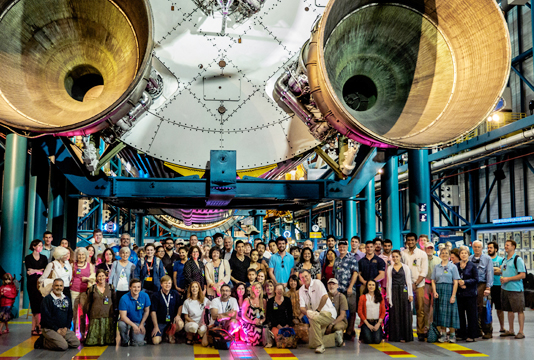Spring 2015
Space Science
WHEN NASA's Magnetospheric Multiscale mission blasted off at 10:45 p.m. EDT on March 12, 2015, a decade's-worth of effort by Space Science Center scientists, engineers, machinists, and students was sent skyward on the first scientific mission dedicated to studying magnetic reconnection—a poorly understood, universal process in which magnetic fields reconfigure themselves and release enormous amounts of energy.
 |
|
| The MMS payload in the process of being lifted onto the Atlas V rocket at the Cape Canaveral Air Force Station Vehicle Integration Facility. Photo courtesy of NASA. |
It can be said that, after the successful launch via a 190-foot Atlas V rocket and deployment of the four, octagonal 11.5 feet (3.5 meters) wide by 3.9 feet (1.2 meters) high satellites, SSC personnel released an enormous, collective sigh of relief.
After all, when $1.1 billion-worth of sophisticated space science hardware, which took an international team from twelve institutes ten years to construct, gets stacked atop of a rocket filled with 313 tons of kerosene and liquid oxygen, it's a risky venture.
Indeed, SSC scientists and engineers recall the moment in 1996 when the European Space Agency four-satellite Cluster mission, which carried a host of UNH-built instruments, failed to achieve orbit soon after launch and sent hopes and hardware up in smoke. It took four years until Cluster II could be constructed and, this time, successfully launched.
Cluster II is still up there doing science and, like MMS, is dedicated to studying aspects of Earth's magnetosphere—a multilayered, comet-shaped magnetic shield that, in its tail, extends as far as 60,000 kilometers away and protects us from dangerous solar and cosmic rays. And, like MMS, the quartet of Cluster satellites allows for three-dimensional, temporal and spatial measurements, which essentially provides for more accurate and comprehensive science (think of watching a baseball game on TV via one camera pointing down the third base foul line—hard to know who’s on first).
But MMS is dedicated largely to probing the inner workings of a very specific phenomenon associated with Earth's magnetosphere—magnetic reconnection. Flying together as a tightly coordinated, pyramid-shaped fleet through the magnetosphere, the MMS probes will be the first to capture magnetic reconnection as it actually occurs in an effort to understand its basic physical process, something that has eluded scientists since the dawn of the space age.
To do so, each satellite carries 25 identical instruments that will provide a multi-dimensional view of the reconnection process as they gather identical data at four different points in space 10 to 100 kilometers apart. This is necessary because the area where magnetic reconnection occurs—the so-called “diffusion region”—is moving about 100 kilometers per second and passes by the satellites in just a tenth of a second. Together, the four satellites will be able to take a snapshot of this “action zone” and provide extremely precise time resolution of the process.
Space Science Center and department of physics scientists, engineers, graduate and undergraduate students constructed two Electron Drift Instruments, (EDI) for each of the four spacecraft and built the central electronic controls for all the instruments built to measure the spectrum of electromagnetic fields around the spacecraft. This "FIELDS" instrument suite is comprised of six sensors per spacecraft.
The team also took the unexpected, add-on task of rescuing the engineering and construction of a mission-critical instrument—the Spin-plane Double Probe—designed to pay out 60 meters (192 feet) of spaghetti-like, high-tech cable tethered to an orange-sized metallic sphere that will measure electric potential in the vacuum of space (see “From Drawing Board to Onboard” in the Winter 2011 Spheres). These spheres will measure the electric fields a safe distance from the spacecraft themselves, which could interfere with getting “pure” signals from the surrounding space.
The task of building the probes added another 16 precision instruments UNH was responsible for and represented the very first time in the SSC’s long, proud history of building space instrumentation that a complex “mechanism” containing moving parts was constructed. This made the SSC team decidedly nervous simply because the more moving parts there are, the more things can go wrong—and you can’t send a mechanic into Earth orbit to unstick a gear or take a kink out of a cable.
So when the actual deployment of these key mission components began during the spacecraft “commissioning” phase, SSC team members once again held their collective breath as the probes were spooled out 17 meters at a time during initial deployment, which was done in stages to reach the full 60 meters.
As of April 24, all 16 of the probes had smoothly and successfully deployed to 60 meters and were getting initial readings of electric fields. Of the achievement, Craig Tooley, project manager for the MMS mission at NASA’s Goddard Space Flight Center, said, “Outstanding! This is truly an accomplishment of science and engineering prowess. But it is also a testament to what can be accomplished by perseverance, without which all the talent and brilliance usually amount to little.”
Additionally, as of April 19, the EDI instrumentation on all four spacecraft were tracking electric and magnetic fields by shooting coded beams of electrons into space and recapturing them as designed after they’ve been bent and displaced in kilometer-sized arcs by the local magnetic and electric fields. “This is another remarkable accomplishment given that there is no vacuum chamber on the planet big enough to have tested this capability prior to launch,” noted UNH MMS FIELDS project manager John Macri.
Roy Torbert, the UNH principal investigator for MMS and mission deputy PI, leads the FIELDS commissioning process. As of May 8th, all FIELDS deployments and instrument checkouts were completed successfully. It will still take several more months of complex preparation before the spacecraft are oriented in their proper orbits and the science phase can swing into full gear.
Reflecting on the decade-long effort undertaken by the SSC, Torbert notes, “In a sense, MMS represents a culmination of the extensive work done in space science at the university. It is based on previous successful NASA and European Space Agency missions in which UNH has participated, such as the Cluster, SOHO, ACE, WIND, and POLAR satellites, as well as our theoretical and numerical simulation work, where the process of reconnection has been observed and simulated, but never studied as rigorously as will be done on MMS.”
Torbert adds, "From this long, complex mission we certainly attained new skills, such as the ability to now build 'mechanisms' but it also provided the realization that UNH cannot do such large missions on its own. I think our SwRI-EOS connection is the only way we could achieve this type of effort in the future. For missions like these there is just too much infrastructure that is too expensive for a relatively small university-based enterprise to maintain."
With an extended mission phase very likely—after all, Cluster is still going 15 years after launch—Torbert believes the prime MMS work, and UNH participation, will continue until 2022.
EOS director Harlan Spence, mission co-investigator on the MMS Energetic Particle Detector Suite (EPD), which is a separate experiment from FIELDS, notes that like all the spacecraft instrumentation EPD continues to go through a period of fine tuning and adjustment so that everything is in sync when the science phase begins.
"Everything is on and appears to be looking good but the temperatures are a little bit lower than we predicted. And since our measurements are temperature dependent, having it a little bit colder means we need to do some additional tweaking—there are a lot of thresholds to tweak given all the individual detector elements we have on the four different spacecraft, which takes a fair amount of time."
Adds Spence, "At this point we could start doing science with the suite but until you have all the spacecraft instruments calibrated and really playing together it's hard to do much that's meaningful. We have already seen how well all the instruments are operating, and have just recently begun looking at particles and fields data together during particularly interesting intervals. We are truly on the verge of having each individual spacecraft ready and then the quartet will come together. That's when the science begins."

